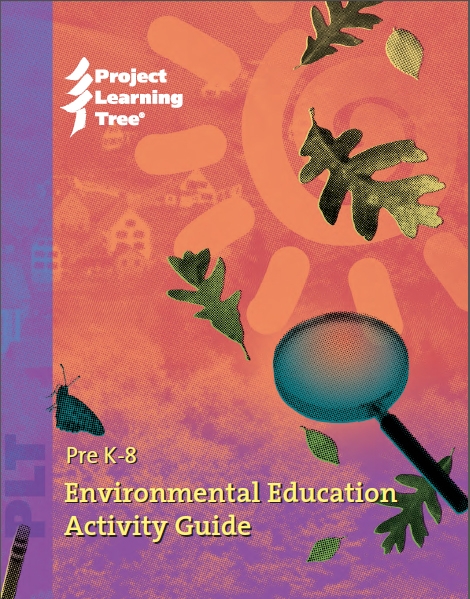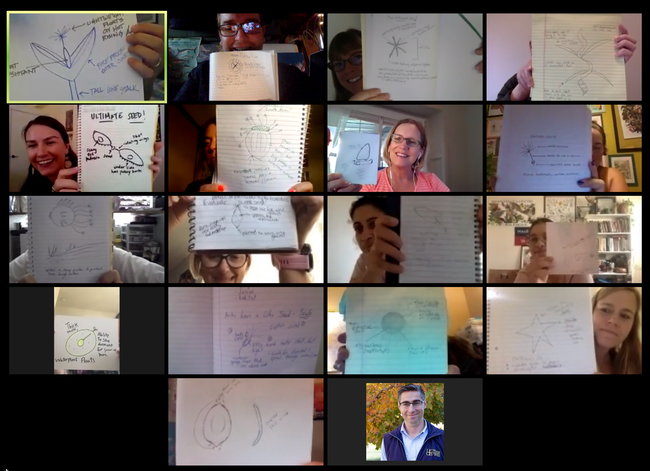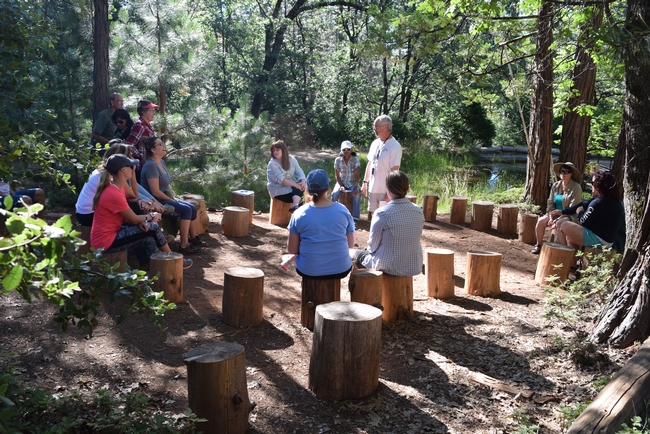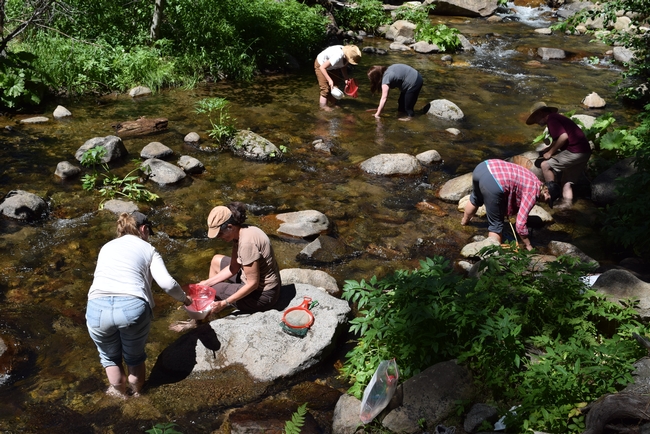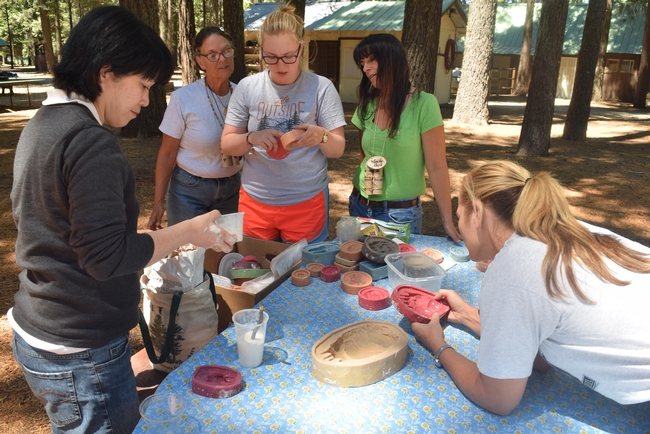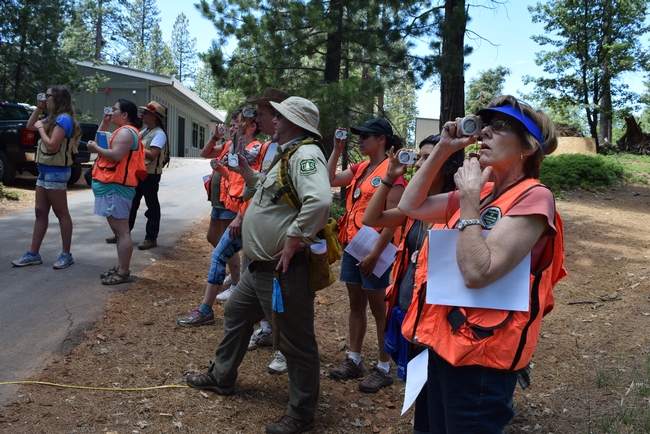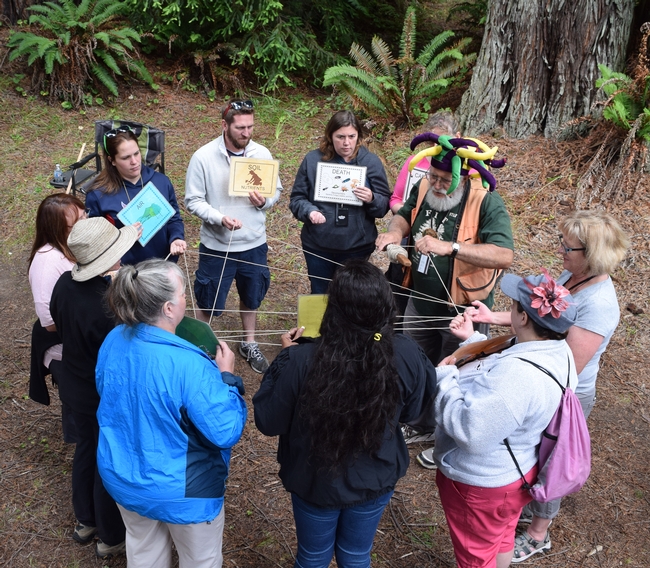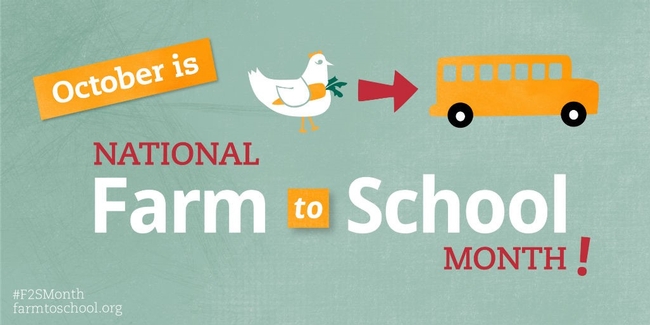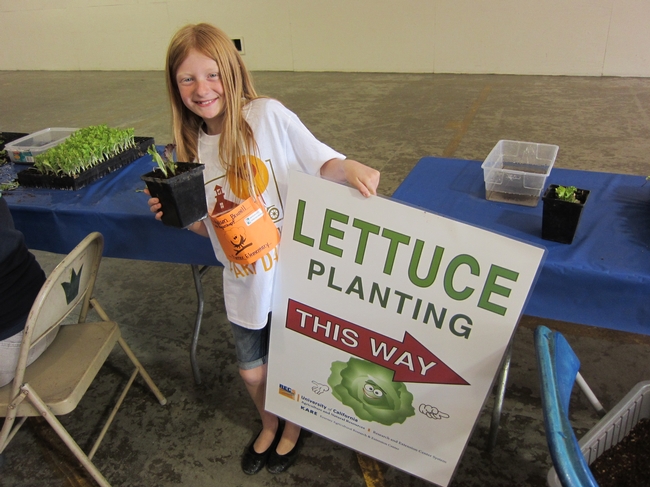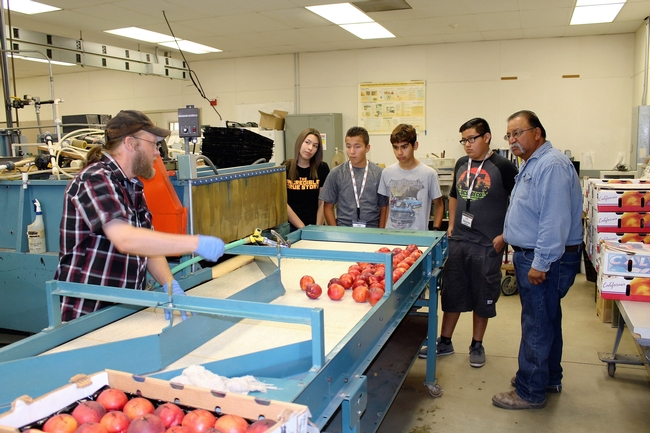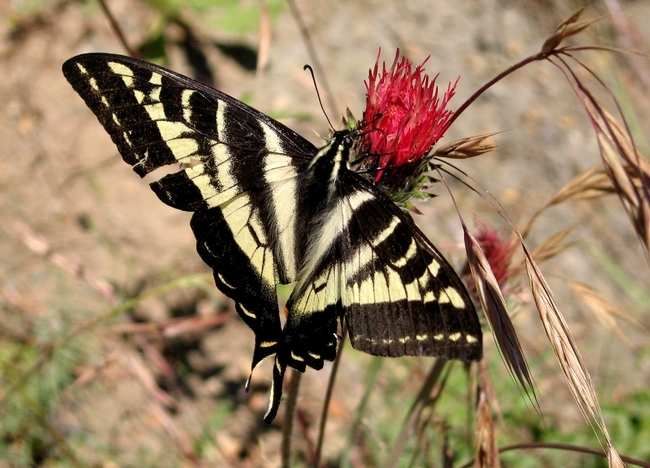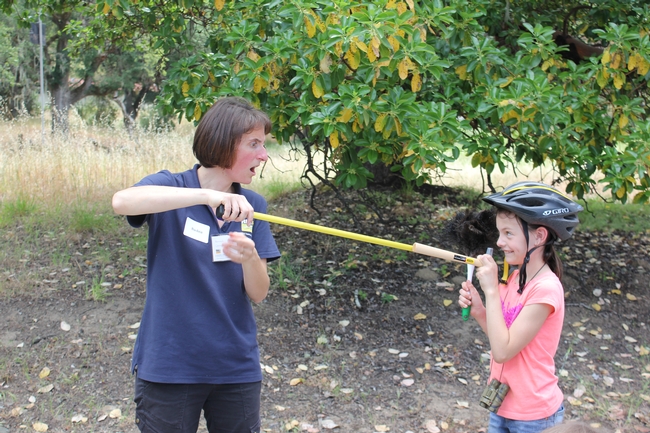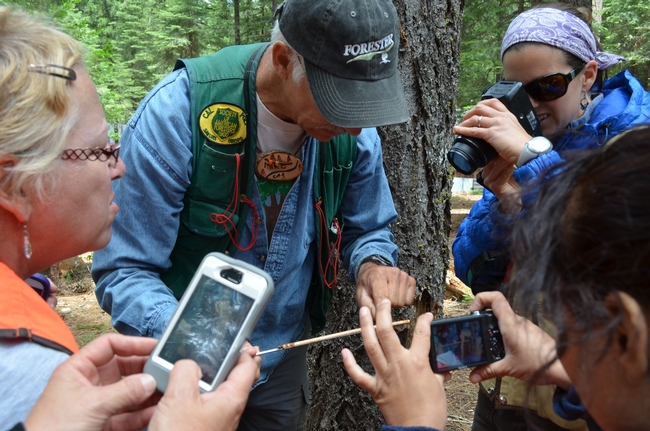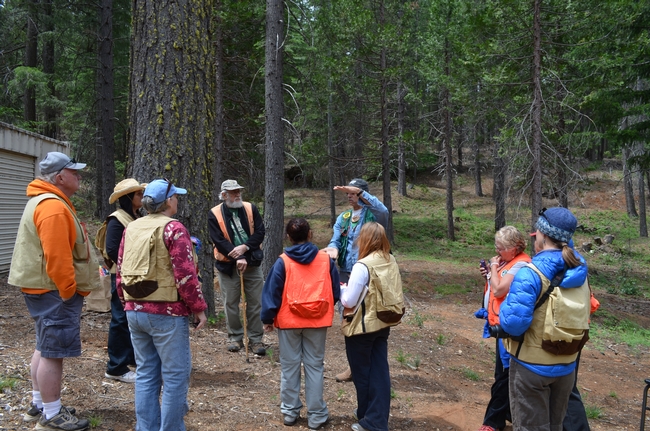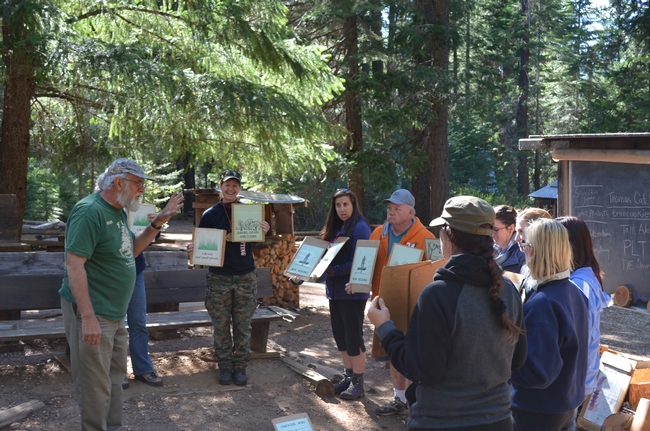Posts Tagged: Project Learning Tree
UC inspires a love of nature to ensure future environmentalists
UC ANR provides the California home of Project Learning Tree, a national program founded in 1973, during the height of an environmental movement sparked by Rachel Carson's seminal book Silent Spring.
“Everyone began to realize we were having an impact on the environment,” said Sandra Derby, Project Learning Tree state coordinator.
Project Learning Tree (PLT), working with the forestry industry, developed an environmental education program and trained teachers to present it to children in formal and informal educational settings. In California, the program is funded by CAL FIRE.
Another UC ANR program, UC California Naturalist, has collaborated with PLT since 2013.
“There is a lot of shared interest in environmental education, stewardship and service in our two programs,” said Greg Ira, director of UC California Naturalist (CalNat). The CalNat Program recruits and certifies a diverse community of volunteers across California to conduct nature education and interpretation, stewardship, participatory science and environmental program support.
During the coronavirus pandemic, CalNat offered PLT courses to school teachers, volunteer educators and parents online. Completion of the six-hour course over three days resulted in their certification for teaching PLT curricula. The book, aimed for children pre-kindergarten to eighth grade, includes 96 activities, with objectives, assessment opportunities, online teaching connections, and more.
The teacher training course offered by CalNat engages participants with the same activities they will employ when teaching nature appreciation to children.
Learning to appreciate the environment
Even though online training focuses attention on a computer screen, the PLT curriculum gets pupils outside. After writing about and discussing a favorite tree from memory, the participants were asked to go outside to gather a variety of leaves around their homes, classrooms or offices. They observed leaf details, and sorted them by observable characteristics.
The participants reconvened and shared their leaves, divided into categories onscreen: Leaves with rough edges, rounded, oval or palmate; rough, waxy, furry and thick; drooping down or reaching up.
Teachers can use additional activities outlined in the curriculum to help students understand natural variations and biodiversity by engaging with the leaves through observation and art. For example, if the training is taking place in person, the children can trade leaves and then look for the trees where their peers found them. Or they can put a leaf under a plain piece of paper and rub the side of a crayon across it to show the leaf's margin, veins and other details.
There are also activities related to common core skills and abilities. For example, different leaf characteristics can be charted in a Venn diagram, with leaves' common characteristics appearing in the center – such as green, pliable, veins – and singular characteristics in the sections that do not overlap.
Making environmental learning accessible
PLT advances environmental literacy using trees and forests as windows on the world, said Cynthia Chavez, PLT community education specialist in Southern California. The hands-on, engaging activities help “teach students how to think, not what to think” about the environment and their place within it.
“Environmental education could be taught in a daunting way,” Chavez said. “PLT opens the door to kids who are different kinds of learners. This is important for environmental education.”
PLT's comprehensive collection of activities have won the confidence of the education community. Curricula is only offered to teachers who have completed workshops so PLT can share a proven system of implementation.
“PLT training encourages students to care for the environment and be interested in pursuing careers in environmentalism. They learn science is not just in the classroom. They could become a field biologist, if that's the way their brain works,” Chavez said.
Expressing engagement with nature in words
Among the ways to connect with nature outlined in the PLT curriculum are reading, journaling and writing. To close the educator training, participants were given 10 minutes outside to draw inspiration from nature and write a poem – haiku, free verse, rhyming or other style.
Below are samples of poetic nature observations written on the fly by teachers who will inspire California young people to appreciate and help conserve the natural world with the help of PLT.
Haiku:
A droplet of sun
Planted firmly in soil
Linking earth to sky
Free verse:
I have botany blindness, always looking for things that scurry, not sway
But I am asked to acknowledge the tree, and I do
A lone palo verde
There's a chevron lizard on the trunk
A small, yellow verdin in the branches
A line of busy ants along the roots
So I am grateful for this tree, after all
It sways, and upon closer inspection, it scurries as well
Rhyming:
A fly comes by
As wind hits my hair
Almost as if
It moved here and there
Then Winston, my dog
Hears someone bark
And a bird starts to chirp
Like a crow or a lark
|
Green Jobs Personality Quiz Project Learning Tree offers a one-time free trial intended for adults to test its Green Jobs Quiz. The quiz helps kids learn what green job fits their personalities. You'll receive information about how to administer this quiz to youth you work with. |
Free forestry workshops to help teachers meet new science standards
California's K-12 teachers are being challenged by the Next Generation Science Standards to find new and more engaging ways to teach science. Adopted by California in 2013, the science-education standards guide how science, technology, engineering and math education are delivered to students in the classroom. The Forestry Institute for Teachers (FIT) offers free environmental education training for teachers in a northern California forest.
“Teachers who participate in the Forestry Institute for Teachers learn to apply Next Generation Science Standards concepts as they develop or refine class lessons using the forest as a lens through which all classroom subject matter can be taught,” said Mike De Lasaux, UC Cooperative Extension natural resources advisor for Plumas and Sierra counties and a FIT instructor.
Learning science through FIT's participatory model is more exciting than memorizing facts from a textbook. In the forest, FIT instructors point out opportunities for students to use technology, engineering and math to better understand the world around them. For example, math can be used to estimate the height of a towering tree. Seeing the “web of life” relationships, such as the effects of rainfall and insects on tree growth, leads to more critical thinking to solve problems.
“The goal of the Forestry Institute for Teachers is to provide K-12 teachers with knowledge, skills and tools to effectively teach their students about forest ecology and forest resource management practices and much more,” said De Lasaux.
California teachers from rural and urban settings are invited to spend a week during the summer working outdoors with natural resources experts to gain a deeper understanding of forest ecosystems and human use of natural resources. The participants are organized by grade level for age-appropriate activities. They take field-trips and do hands-on activities such as examining the rings in a tree's cross-section to learn about events – such as wet or dry periods, insect or disease damage – that have occurred during the tree's lifetime.
The Forestry Institute for Teachers has been providing science education and other subject content to California K-12 teachers since 1993 with more than 2,500 educators completing the program.
FIT is a week-long residence program developed by the Northern California Society of American Foresters in collaboration with the University of California Agriculture and Natural Resources' Cooperative Extension, the USDA Forest Service, CALFIRE and other entities. The FIT Program is underwritten by a consortium of public and private sources.
FIT is offered in forested settings in four different Northern California locations:
- June 11-17 in Plumas County
- June 18-24 in Tuolumne County
- July 2-8 in Shasta County
- July 9-15 in Humboldt County
There is an application fee of $25, but training, meals and lodging are free for first-time participants.To watch videos of past participants discussing their FIT experience and to apply to attend, visit www.forestryinstitute.org.
October is National Farm-to-School Month
Schools across the country are celebrating local connections to local food producers in October during National Farm to School Month. Education and outreach activities such as school gardens, cooking lessons and field trips are teaching students about healthy, local foods and food's journey from the farm to their forks.
There are plenty of opportunities for teachers and schools to celebrate and get involved in National Farm to School Month with the University of California Division of Agriculture and Natural Resources (UC ANR). Here are a few ideas to get you started.
4-H youth development
Launch a 4-H Club at your school. The 4-H Youth Development Program emphasizes enrichment education through inquiry-based learning. Core content areas include Healthy Living as well as Science, Technology, Engineering and Math (STEM). Clubs have access to a wealth of curricula materials exploring food, agriculture and natural resources. 4-H also offers the Ag in the Classroom school enrichment program.
Boots on the ground
Invite UC ANR academics and program staff to your career day or science fair or to make a classroom presentation. Specialists from Master Gardeners, Nutrition Education, Project Learning Tree, California Naturalist and other UC ANR programs know how to engage and inspire your students.
Some programs, including Project Learning Tree, offer "train the trainer" professional development workshops that equip educators with the skills and knowledge to teach concepts in their own classrooms. Project Learning Tree also provides free activity guides to teachers who attend their workshops. The guides highlight differentiated instruction, reading connections, and assessment strategies and offer ideas to integrate technology into classroom instruction,
Research and Extension Centers
Take your students on a field trip to a UC ANR Research and Extension Center (REC). The nine RECs in California are focal points for community participation and for active involvement in current and relevant regional agricultural and natural resource challenges.
Visiting a REC offers students a unique opportunity to learn about food production through the lens of applied science research in plant pathology, integrated pest management, conservation tillage, water conservation, development of new crop varieties, and much more. Some RECs also host extended education programs such as Sustainable You! Summer Camp and FARM SMART.
The 2016 National Farm to School Month theme is One Small Step, which highlights the easy ways anyone can get informed, get involved and take action to advance farm to school in their own communities and across the country.
Each week will have a different focus:
- Education (October 3-7)
- Healthy School Meals (October 10-14)
- Farmers & Producers (October 17-21)
- The Next Generation (October 24-28)
Join the celebrations by signing the One Small Step pledge then take your own small step to support healthy kids, thriving farms and vibrant communities this October by partnering with UC ANR.
This story en español.
Here are your clues: A helmet, a feather duster and a tape measure…
As a newly employed community educator at the Hopland Research and Extension Center, I believe the time is ripe to consider how our facility can provide the hands-on experience that all these programs require.
Many of these initiatives aim to represent the real world of scientific investigation and environmental issues relevant to their state. I am lucky enough to interact on a daily basis with researchers working at the sharp end of scientific discovery, in an environment chosen to represent one of California's key ecosystems. What better blend could there be to allow our local school and college students the chance to witness agriculture and natural resource management in it's complex and dynamic true state?
Of course collaboration and creating programs always takes time and effort! Projects like 4H, California Regional Environmental Education Community and Project Learning Tree make the process much more efficient. They have put together activities that can be easily taken off the shelf and used to appropriately represent the diversity of systems which can be seen through the Research and Extension Centers.
Recently, I hosted my first field trip at Hopland Research and Extension Center, which covers 5,300 acres of oak woodland and chaparral habitat. A busy group of third-graders tumbled from their vehicles clutching their tablets, phones and cameras ready to document their fieldtrip digitally at every stage. The first step to connect with nature, is of course to disconnect! Having packed away their media devices, it was time to figure out some mysteries… third grade provides a great opportunity to look at adaptation and luckily we could easily observe a species well equipped for its environment right on our doorstep!
As well as observing this particularly well-represented species, we worked on our own scientific questioning and asked, “In which habitat at HREC will we see the most species of birds?” Our volunteer bird expert Chuck Vaughn helped students identify and even showed them a great use for those stowed-away digital devices by identifying and playing bird calls from his phone as we observed and learned.
Creating the perfect program and meeting the needs of educators, students, standards, and curriculum resources might be a balancing act, but working with UC ANR at one of the REC's allows full immersion in a habitat where science can come to light. I hope to see one of those students return to the Hopland REC as a fully-fledged researcher in future years … and look forward to seeing the outcome!
Author: Hannah Bird
Teachers invited to learn about natural resources in the forest
California teachers are invited to spend a week in a northern California forest this summer and participate in the Forestry Institute for Teachers.
“The goal of the Forestry Institute for Teachers, or FIT, is to provide K-12 teachers with knowledge, skills and tools to teach their students about forest ecology and forest resource management practices and introduce them to environmental education curriculum such as Project Learning Tree, Project WILD and California's Education and the Environment,” said Mike De Lasaux, UC Agriculture and Natural Resources Cooperative Extension advisor for Plumas and Sierra counties and a FIT instructor.
The program, which is in its 23rd year, brings teachers from rural and urban settings together with natural resources experts to gain a deeper understanding of the relationship between forest ecosystems and human use of natural resources. The environment becomes the basis for learning in many subject areas, including environmental science, physical science, social science, biology, forestry and history.
“FIT gave me a lot of physical group activities and ideas for how to get to know a new group of people,” said Renata Martin, who is a substitute teacher for grades 3 through 8 in the San Francisco Bay Area.
By examining the rings in a tree's cross-section, foresters can tell a lot about events – such as wet or dry periods, insect or disease damage – that have occurred during the tree's lifetime. She has used the tree analogy to teach students that important events shape their own lives.
“Especially because I meet new kids every day, I've been able to use the lesson that we did around the campfire the first night with sharing important points in our lives as if they were tree cookies” or slices of a tree, said Martin.
FIT emphasizes California Department of Education Content Standards including Common Core and Next Generation Science Standards. Since 1993, more than 2,200 teachers have graduated from the program.
Using what they learn at the workshop, the participants conduct training for their colleagues and develop a forestry education project for their students during the school year.
Martin, who participated in FIT in 2014 in Plumas County, said she has adapted many of the lessons for her students based on their age, development and behavior.
Four 1-week FIT sessions are scheduled at four different locations: Plumas, Tuolumne, Shasta and Humboldt counties.
Two June sessions will be held at the University of California Forestry Camp, close to Quincy in Plumas County, and at Sierra Outdoor School near Sonora in Tuolumne County. The July sessions will be at Camp McCumber just east of Shingletown in Shasta County and at Humboldt State University in Arcata in Humboldt County.
The presenters and staff include public and private forest resource specialists and other natural resource managers, environmental activists and science and environmental education curriculum specialists. Groups are welcome to register as teams. There is an application fee of $25, but training, meals and lodging are free for first-time participants.
The deadline for applications is March 16. For more information and to apply, visit http://forestryinstitute.org or call the Forest Stewardship Helpline at (800) 783-8733.
The Forestry Institute for Teachers (FIT) workshop was developed by the Northern California Society of American Foresters, University of California Agriculture and Natural Resources Cooperative Extension, Shasta County Office of Education, The California Department of Forestry and Fire Protection, and Project Learning Tree. The FIT Program is underwritten by a consortium of public and private sources.
An initiative to maintain and enhance sustainable natural ecosystems is part of UC Agriculture and Natural Resources Strategic Vision 2025.

